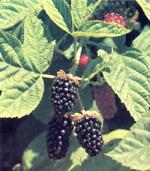| Fruits |
Vegetables
|
Blackberry, Rubus fruticosus / Rosaceae
|
Note: Composition for 100 g. of fresh product Values in ( min. - max. ) format. | |
| Energy: 25.00-43.92 kcal Fats: 0.20-1.00 g Fibres: 3.10-3.16 g Minerals Calcium: 41.00-44.00 mgZinc: 0.20-0.20 mg Chlorine: 22.00-22.00 mg Phosporus: 30.00-31.00 mg Iron: 0.700-0.900 mg Magnesium: 23.00-30.00 mg Manganese: 0.894-1.40 mg Potasium: 160.00-189.00 mg Sodium: 2.00-3.00 mg Iodine: 0.40-0.40 µg | Proteins: 0.90-1.20 kcal Carbohidrates: 5.10-6.24 g Liposoluble Vitamins A Retinol: 0.00-45.00 µgA Carotenoids: 80.00-270.00 µg E or Tocoferol: 2.37-2.70 mg Liposoluble Vitamins B1 or Thiamine: 0.020-0.030 mgB2 or Riboflavine: 0.040-0.050 mg B3 or Niacine: 0.50-0.50 mg B5 or Pantothenic Acid: 0.220-0.250 mg B6 or Piridoxine: 0.050-0.050 mg B9 or Folic Acid: 15.00-17.00 mg C or Ascorbic Acid: 15.00-17.00 mg |

The blackberry is a wild plant, in general, of which we eat the fruits, very aromatic and somewhat acid small berries of black colour. They are consumed raw, although they are also used for making stewed fruit, fruit salads, cakes, etc. They are rich in vitamins and minerals. Besides, they supply fibre and they are low in calories.
Nutrition and eating
The blackberry has many healing properties. One can use the fruits, the leaves and the tender shoots to cure several diseases like diabetes, angina or ulcers.
The fruit
 The blackberry is a wild plant, in general, of which we eat the fruits, very aromatic and somewhat acid small berries of black colour. They are consumed raw, although they are also used for making stewed fruit, fruit salads, cakes, etc. They are rich in vitamins and minerals. Besides, they supply fibre and they are low in calories.
The blackberry is a wild plant, in general, of which we eat the fruits, very aromatic and somewhat acid small berries of black colour. They are consumed raw, although they are also used for making stewed fruit, fruit salads, cakes, etc. They are rich in vitamins and minerals. Besides, they supply fibre and they are low in calories.The blackberry is the fruit of the bramble, a shrub that grows generally wild in many areas of the world. It is a black glossy berry-like fruit formed by multiple small fruits, each one containing a seed. It is an aromatic and somewhat acid fruit.
It is a species known from the very old times, to which people confer many healing properties. They are consumed raw, on their own or along with ice cream, yoghurt or cream. They are used to make fruit salads, stewed fruit, cakes, wines and brandy, etc.
The blackberry provides a lot of fibre and few calories, since it is low in proteins and fats. It is remarkably rich in vitamins, mainly A and C, and potassium, which confers it a diuretic property. It also supplies several substances that have anti-carcinogenic effects.
The plant
The bramble is a shrub that forms thorny stems of 4m of length that drags along the ground. The flowers, which are of pink or white colour, form some berries that in fact are the grouping of many small black fruits.
The blackberry belongs to the family of the Rosaceous; the scientific name is Rubus fruticosus. The plant is a sarmentose shrub with stems of 3-4 meters long. These stems at the beginning, grow turgid, although they are stretched out and they end up crawling on the ground. These stems are bent and strongly thorny.
The leaves are deciduous and alternate, composed of 3-7 oval or elliptical folioles with sawed edges.
The flowers are pink or white, with five petals. They are solitary or grouped in clusters. The plant blooms between June and August in Spain, according to the climatic conditions. The fruit is formed by the gathering of multiple small and rounded fruits, each one with their own seed. At the beginning it is green, then red; when they mature they turn into an almost black and juicy fruit.
The bramble has long roots that grow in little depth, of which new buds sprout quite easily. These sprouts are isolated and cultivated separately to obtain new plants.
The blackberry belongs to the family of the Rosaceous; the scientific name is Rubus fruticosus. The plant is a sarmentose shrub with stems of 3-4 meters long. These stems at the beginning, grow turgid, although they are stretched out and they end up crawling on the ground. These stems are bent and strongly thorny.
The leaves are deciduous and alternate, composed of 3-7 oval or elliptical folioles with sawed edges.
The flowers are pink or white, with five petals. They are solitary or grouped in clusters. The plant blooms between June and August in Spain, according to the climatic conditions. The fruit is formed by the gathering of multiple small and rounded fruits, each one with their own seed. At the beginning it is green, then red; when they mature they turn into an almost black and juicy fruit.
The bramble has long roots that grow in little depth, of which new buds sprout quite easily. These sprouts are isolated and cultivated separately to obtain new plants.
| Interempresas Media, S.L. / 2025 | [ Legal notice | Política de Protección de Datos | Política de cookies | Publicidad] |
